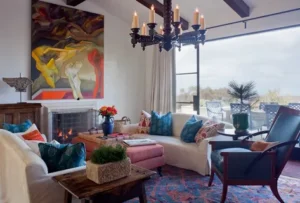Modern vs. Traditional Renovation Styles
When planning a home renovation, one of the most significant decisions you’ll face is choosing between modern renovation styles and traditional renovation styles. Both approaches offer distinct aesthetics, functionality, and benefits. In this comprehensive guide, we will explore the key differences, pros, and cons, as well as expert tips to help you make the right choice for your dream home.

This image presents a split-view comparison between a sleek modern living room with clean lines and neutral tones on the left, and a cozy traditional living room with ornate furniture and warm colors on the right.
What is Modern Renovation Style?
Modern renovation style embraces clean lines, minimalistic design, open spaces, and innovative materials. It focuses on simplicity, functionality, and the integration of technology to enhance comfort and efficiency.
Key Characteristics of Modern Renovation
-
Minimalism: Emphasises clutter-free spaces with sleek, straight lines.
-
Neutral Colour Palette: Shades like white, grey, and beige dominate, often complemented by bold accent colours.
-
Open Floor Plans: Creates a sense of flow and spaciousness.
-
Natural Light: Large windows, glass walls, and skylights to maximise light.
-
Smart Home Features: Automation systems for lighting, temperature, and security.
-
Innovative Materials: Use of steel, glass, concrete, and engineered wood.
Advantages of Modern Renovation
-
Energy Efficiency: Incorporates eco-friendly materials and smart appliances.
-
Low Maintenance: Minimalist design reduces upkeep.
-
Resale Value: Highly appealing to younger buyers and urban homeowners.
What is traditional renovation style?
Traditional renovation style reflects timeless elegance, classic details, and warm aesthetics. It draws inspiration from historical architecture and emphasises comfort and familiarity.
Key Characteristics of Traditional Renovation
-
Rich Detailing: Crown mouldings, wainscoting, and decorative trims.
-
Warm Color Palette: Earth tones, deep reds, browns, and gold accents.
-
Natural Materials: Solid wood, natural stone, and high-quality fabrics.
-
Symmetry: Balanced layouts and formal design elements.
-
Classic Furniture: Ornate, carved, and upholstered pieces.
Advantages of Traditional Renovation
-
Timeless Appeal: Never goes out of style and suits all generations.
-
Durability: High-quality natural materials ensure longevity.
-
Personalisation: Offers more opportunities for decorative accents.
Modern vs. Traditional Renovation: The Key Differences
| Feature | Modern Style | Traditional Style |
|---|---|---|
| Design Philosophy | Minimalism, sleek, and contemporary | Classic, elegant, and ornate |
| Color Scheme | Neutral with bold accents | Warm, rich, and earthy tones |
| Materials | Glass, steel, engineered wood | Solid wood, stone, and natural materials |
| Layout | Open floor plans | Defined, separate rooms |
| Technology | Smart home integration | Limited to basic conveniences |
| Maintenance | Low-maintenance | Requires more upkeep due to intricate detailing |
How to Choose the Right Renovation Style?
When deciding between modern and traditional renovation styles, consider these factors:
-
Personal Taste: Do you prefer sleek minimalism or classic elegance?
-
Home Architecture: Modern designs fit contemporary structures, while traditional styles complement historical homes.
-
Budget: Modern renovations can be more cost-effective due to simple finishes, whereas traditional styles often involve premium materials.
-
Functionality: If you value innovative technology and energy efficiency, modern is ideal. For warmth and character, traditional is the winner.
-
Resale Market: Research what appeals to buyers in your area.
Blending Modern and Traditional Styles
A growing trend is the transitional renovation style, which combines the clean lines of modern design with the warmth of traditional elements. Examples include:
-
Modern kitchens with shaker cabinets and quartz countertops.
-
Traditional living rooms accented with minimalist lighting fixtures.
-
Neutral colour schemes enhanced by classic mouldings.
This approach delivers the best of both worlds, offering elegance with a touch of contemporary flair.

“A living room that combines modern and traditional elements, featuring a sleek contemporary sofa paired with a classic wooden coffee table, neutral walls accented by vintage décor pieces.”
Cost Comparison: Modern vs. Traditional Renovation
| Aspect | Modern Renovation | Traditional Renovation |
|---|---|---|
| Average Cost | $50,000 – $150,000 | $80,000 – $200,000 |
| Materials | Affordable options available | Typically more expensive due to premium materials |
| Labor | Standard skills required | Skilled craftsmanship is needed for intricate details |
Top Renovation Tips for Success
-
Set a Realistic Budget: Factor in materials, labor, and contingencies.
-
Hire Experienced Contractors: Look for specialists in your chosen style.
-
Incorporate Energy-Efficient Features: Regardless of style, opt for sustainability.
-
Focus on Lighting: Proper lighting enhances both modern and traditional interiors.
-
Stay True to Your Vision: Avoid mixing too many styles, unless going for a transitional design.

“Planning a remodel? Here are the top renovation tips you need for a smooth and successful transformation.”
Conclusion:
Both modern and traditional renovation styles have their unique charm. Modern designs offer simplicity, functionality, and tech-savviness, while traditional styles deliver elegance, warmth, and timeless beauty. The best choice depends on your lifestyle, home architecture, and personal preferences.
FAQs
1. Which renovation style is pricier?
Traditional renovations are typically more expensive due to the use of premium materials and intricate craftsmanship.
2. Can I mix modern and traditional styles?
Yes, a transitional style combines elements of both, creating a balanced and unique look.
3. Which style is better for resale value?
Modern renovations often attract younger buyers, while traditional styles appeal to those seeking elegance and a sense of heritage.
4. Is modern renovation more sustainable?
Typically, yes. Modern designs often include energy-efficient appliances, eco-friendly materials, and smart home features.
5. What is the most popular renovation trend in 2025?
The transitional style is gaining popularity, blending modern functionality with traditional charm.
